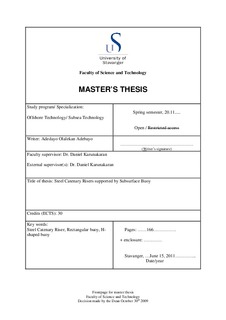| dc.description.abstract | Oil and gas exploration and production activities in deep and ultra deep waters in hostile environments necessitates the need to develop innovative riser systems capable of ensuring transfer of fluids from the seabed to a floating vessel and vice versa, with little or no issues with respect to influences of environmental loads and vessel motions.
Over the years, studies have shown that the conventional flexible riser and steel catenary riser configurations cannot function effectively under such environmental and vessel motion influences as a result of issues such as collapse (predominant in flexible risers when used in deep waters), and fatigue (predominant in steel catenary risers). Nevertheless, a riser system known as the hybrid riser which is a combination of a vertical rigid riser and a flexible riser has been used effectively under these seeming adverse conditions and has been found effective. However, it is regarded as an expensive option considering the cost of its components, in addition to its limitation in terms of step-out distance between the floating vessel and a subsea well.
The limitations of the aforementioned riser systems are conveniently accommodated by a riser system presently undergoing development. It is known as “steel catenary risers supported by subsurface buoy”. This riser solution combines the best properties of flexible risers (ability to uncouple a system from vessel motions) and steel catenary risers (usability in deep waters). In addition to this, it offers flexibility in terms of achievable step-out distance between a floater and a subsea well. This riser system is the thrust of this thesis.
This write-up begins with a review of the previously mentioned riser solutions, pros and cons related to their usage in harsh deep water environments, and some essential design code requirements to be fulfilled in a riser design activity. This is followed by design analysis of the thesis example riser system.
In-depth analysis is done with two different buoy types (rectangular buoy and H-shaped buoy) by conducting sensitivity studies to understand the contribution of factors such as the buoy size and submerged weight, flowline content density, riser anchor length, and so on, to the performance of the riser system in a typical North Sea environment. Observation was made that whilst both buoy shapes result in good flexible risers and steel catenary risers strength performance, the H-shaped buoy had line clashing issues when subjected to cross flow environmental loads. This was however eradicated through the use of another buoy shape referred to as the modified H-buoy.
The rectangular and H-shaped buoys were further studied for possibility of resonance with peak waves obtainable in the North Sea environment and were found to have satisfactory sway and heave periods.
In addition, a brief fatigue assessment was carried out with the rectangular buoy to show that the riser system helps in alleviating fatigue issues prominent in conventional steel catenary risers.
The study concludes by showing that while both the conventional buoy and the H-shaped buoy offer appreciable strength performance and stability to the riser system, the latter has better stability in comparison with the former while the former offers better strength performance to the steel catenary risers.
Keywords: Steel Catenary Riser, Rectangular buoy, H-shaped buoy. | en_US |
